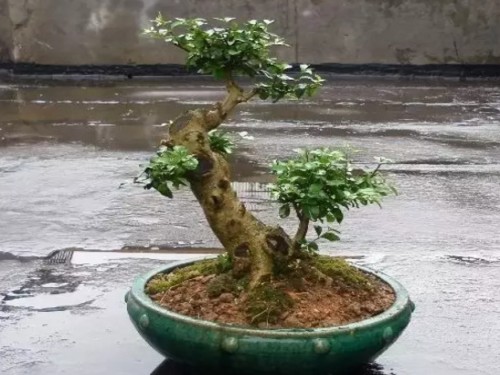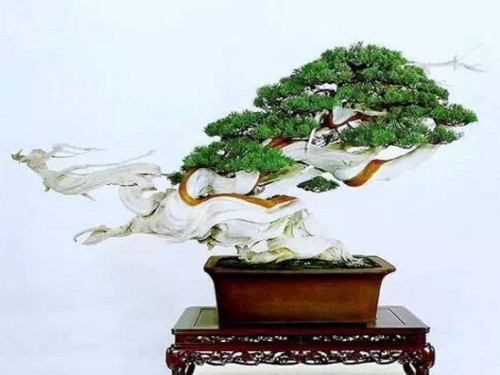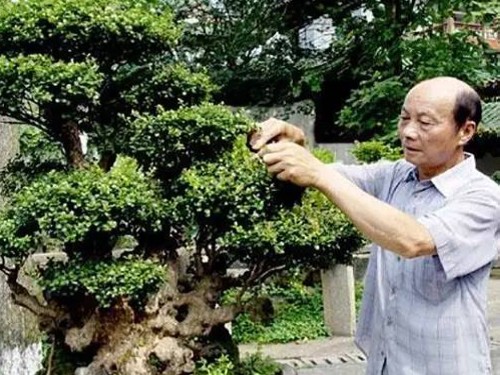Modeling technology of bonsai of holly
Many studies have shown that holly is not only of medicinal value, but also an excellent landscaping tree species, its wild original species and cultivated varieties have strong cold tolerance, even if introduced to Shandong, it also shows good growth potential. Therefore, some scholars believe that many holly species and varieties can be introduced to North China, central and southern China to provide new tree species resources for local landscaping.
Ilex spinifera is an evergreen shrub or small tree of the genus Lycium of Holly family, with bluish gray stem, lanceolate or oval-shaped leaves, sharp teeth at the edge, dark green of old leaves, tender green of new leaves, red, fresh and beautiful, extremely beautiful. Its leaves are small and dense, evergreen all the year round, strong germination and resistance to pruning, making it very suitable for making bonsai.

The excavation and transplanting of Ilex angustifolia is mostly carried out before sprouting in spring, its root system is developed, there are many whisker roots, and the transplanting is easy to survive. Cut off unnecessary branches before transplanting, cut off the main root, leave more fine roots and whisker roots, dig or apply mud or plastic bags for fresh and moisturizing, should be planted as soon as possible.
The stump is reshaped before planting, cutting off unnecessary branches and over-long roots, first planting in a tile basin or underground "raising billet", watering through the fixed root water after planting, spraying water on the trunk, and then covering it with plastic sheet. after that, pay attention to the moisture in the soil and shed, replenish water in time, as the weather turns warm, the stump will sprout, and the plastic film can be opened step by step to ventilate the seedlings. The branches germinated by the stump planted in that year can be allowed to grow naturally and should not be cut off so that they can produce more nutrients through photosynthesis, which is conducive to the restoration of root growth, and wait until the next year for sprouting, pruning or modeling.
The stump of holly is rich in shape, and can be processed into different forms of bonsai, such as single-dry type, double-dry type, jungle type, multi-dry type, cliff type, water-facing type and so on. The canopy can not only be shaped into a natural type of natural evacuation, but also can be trimmed into a regular disc type.
The modeling method is a combination of pruning and flat binding, which is mostly carried out in October and pruned in late autumn and early winter. The bonsai made of Ilex holly can be moved into a small basin such as purple sand basin in spring or plum rain season to watch. Because its root system is developed, part of its roots can be raised to the soil surface to show its roots and claws, so as to reflect the characteristics of vitality and simplicity, and mountains and rocks can be placed on the basin surface according to the need. Ilex angustifolia is suitable for growing in a warm, humid, sunny environment, resistant to semi-shade and has a certain degree of cold resistance. Usually the management is relatively extensive, do not fertilize the stump transplanted in that year, replenish water in time when the basin soil is dry, and pay attention to shading when high temperature in summer to prevent hot sun exposure. The second year's growing season can apply mature thin liquid fertilizer every 20 days, without shading in summer, usually keep the basin soil moist, spray some water to the leaves when the air is dry, in order to increase air humidity and make the leaves bright and green. Remove the new branches and buds that affect the shape of the tree at any time during the growing period to maintain the beauty of the bonsai.
Pruning and shaping is carried out at the end of autumn and the beginning of winter every year to cut off diseased branches, cross branches, parallel branches and dead branches, so that the inner chamber of bonsai is ventilated and transparent. Move indoors in winter, the overwintering temperature should be kept at 0 ℃ to 10 ℃, do not apply fertilizer, do not irrigate too much water. When the basin is turned every 2 to 3 years in spring, it is not strict with the soil, but it grows better in the sandy soil with loose and fertile soil and good drainage and permeability.
Time: 2019-06-10 Click:
- Prev

How to raise cypress bonsai (maintenance skills)
Cypress, evergreen tree, used for potted plants indoors and courtyards for ornamental purposes. With its unique leaf alternately falling off, generated but not easy to detect the special generating structure, so that it has a sense of everlasting. Such as true cypress, its branches are dense and leaves are thin, stem-shaped flexion, branchlets ascending, dense clumps, quaint and strange posture.
- Next

Daily pruning skills of bonsai
The daily sporadic pruning of bonsai refers to the timely pruning in daily maintenance. Bonsai stumps cultivated by shrubs, their habits into clusters, bonsai modeling can be cultivated into small trees to improve its ornamental effect, so that it is originally a small shrub, but appears in the basin into a towering tree. To the material.
Related
- Fuxing push coffee new agricultural production and marketing class: lack of small-scale processing plants
- Jujube rice field leisure farm deep ploughing Yilan for five years to create a space for organic food and play
- Nongyu Farm-A trial of organic papaya for brave women with advanced technology
- Four points for attention in the prevention and control of diseases and insect pests of edible fungi
- How to add nutrient solution to Edible Fungi
- Is there any good way to control edible fungus mites?
- Open Inoculation Technology of Edible Fungi
- Is there any clever way to use fertilizer for edible fungus in winter?
- What agents are used to kill the pathogens of edible fungi in the mushroom shed?
- Rapid drying of Edible Fungi

